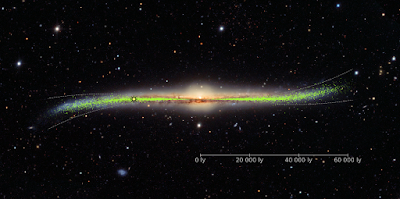Ένας
νέος τρισδιάστατος χάρτης του Γαλαξία μας. If we could see it
from outside, our home galaxy would not be a flat disk, but would look more
like a poached egg sliding off a slotted spoon. This artist's illustrations
shows our galaxy's warped disk, traced out by young variable stars called
Cepheids (green points). Image credit: J. Skowron / OGLE / Astronomical
Observatory, University of Warsaw
Αστρονόμοι
χρησιμoποιώντας τους
μεταβλητούς αστέρες Κηφείδες σχεδίασαν μια ακριβέστερη τρισδιάστατη απεικόνιση
του Γαλαξία μας.
Over the course of
days or even months, Cepheid stars grow brighter and dimmer in regular cycles.
The longer the cycle, the more light the star is actually producing, so by
measuring the tempo of a Cepheid variable star, astronomers can understand how
far away that star is. Image
by Przemek Mróz / OGLE
Η
λαμπρότητα των Κηφείδων μεταβάλλεται περιοδικά και οι αστρονόμοι τους
χρησιμοποιούν για να υπολογίσουν αποστάσεις στο Σύμπαν και στον Γαλαξία μας.
Distribution of
Galactic classical Cepheids. Top: on-sky view of the Milky Way in galactic
coordinates, with the team’s sample of classical Cepheids in the Milky Way and
in the Magellanic Clouds. Cepheids from the OGLE project are shown with yellow
dots, other sources with cyan dots. Bottom: face-on view of our Galaxy with all
2,431 Cepheids in the sample marked with green dots. The background image
represents a four-arm spiral galaxy model consistent with neutral hydrogen
measurements in our Galaxy. The Sun is marked with a yellow dot. Image credit:
Serge Brunier / ESO / Skowron et al, doi: 10.1126/science.aau3181.
Ο
νέος τρισδιάστατος χάρτης του Γαλαξία που κατασκευάστηκε χρησιμοποιώντας πάνω
από 2.400 Κηφείδες, δείχνει ότι ο δίσκος του Γαλαξία δεν είναι επίπεδος, αλλά
στρεβλώνεται σε αποστάσεις μεγαλύτερες από 25.000 έτη φωτός από το κέντρο του
Γαλαξιακού κέντρου.
The Milky Way’s
Cepheid stars are plotted in three dimensions, revealing the galaxy’s warped
shape. Unlike other stars, Cepheids vary in brightness in a particular way that
helps scientists make more precise estimates of their distances from Earth.
Brighter colors represent Cepheids closer to the warped plane of the galaxy,
indicated by the grid. The star icon indicates the sun. Video: J.
Skowron/OGLE/Astronomical Observatory/Univ. of Warsaw
Υπενθυμίζεται
ότι η διάμετρος του Γαλαξία μας είναι 120.000 έτη φωτός και ότι το ηλιακό μας
σύστημα βρίσκεται σε απόσταση 27.000 έτη φωτός από το κέντρο του.
Colored dots
represent older (red) and younger (blue) stars in the Milky Way belonging to
three stellar groups that seem to have formed in relatively recent bursts. ©
Image by J. Skowron/OGLE/Astronomical Observatory, University of Warsaw
Παρότι
ο δίσκος του Γαλαξία μας συνήθως απεικονίζεται επίπεδος, παλαιότερες έρευνες
έδειξαν ότι καμπυλώνεται στα άκρα του. Η νέα μελέτη από αστρονόμους του
Πανεπιστημίου της Βαρσοβίας δείχνει πως η καμπύλωση είναι ακόμη μεγαλύτερη.
Πηγές: https://science.sciencemag.org/content/365/6452/478 - http://en.uw.edu.pl/the-milky-way-in-three-dimensions/ - https://www.nationalgeographic.com/science/2019/08/milky-way-galaxy-has-warped-disk-star-map-confirms/ - physicsgg





Δεν υπάρχουν σχόλια:
Δημοσίευση σχολίου